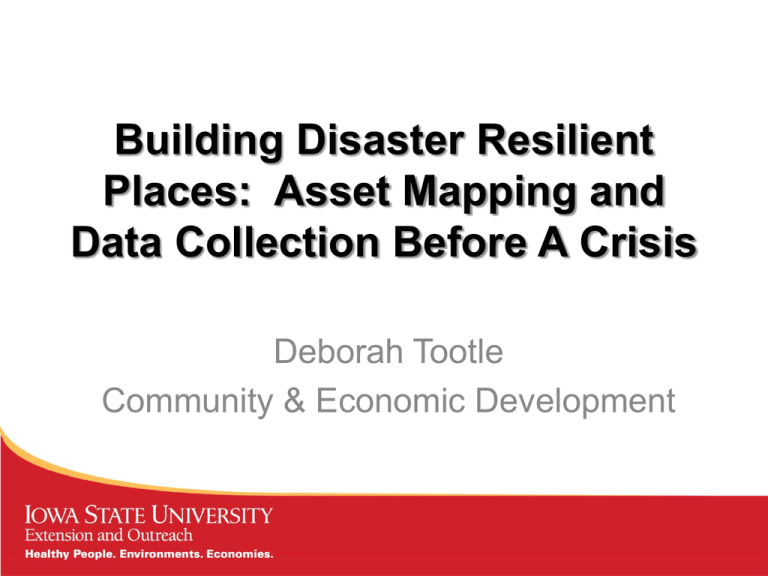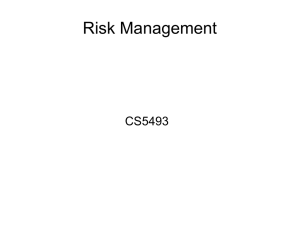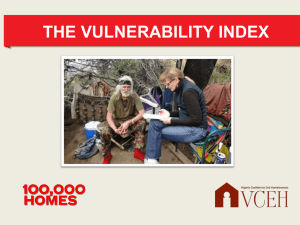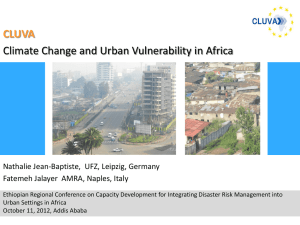Vulnerability Assessment
advertisement

Building Disaster Resilient Places: Asset Mapping and Data Collection Before A Crisis Deborah Tootle Community & Economic Development Overview • • • • Introduction to disasters Vulnerability and resilience Why asset mapping? Vulnerability assessment and asset identification • Pulling it all together Overview • • • • Introduction to disasters Vulnerability and resilience Why asset mapping? Vulnerability assessment and asset identification • Pulling it all together Introduction to Disasters • What is a disaster? Introduction • What is a disaster? – A disaster is generally the result of a natural catastrophic event, a technological or human caused incident that results in severe property damage, multiple injuries or death. – A disaster also disrupts socioeconomic processes and conditions in the affected area. Disaster Management Cycle Mitigation and Prevention • Efforts to reduce loss of life and property by reducing impacts of disasters • Usually refers to physical or structural activities or approaches – such as developing or implementing building codes Mitigation and Prevention • Efforts to reduce loss of life and property by reducing impacts of disasters • Usually refers to physical or structural activities or approaches – such as developing or implementing building codes What are some examples of mitigation? Preparedness Wide array of protective activities at all levels: • Federal • State • Local • Organizational • Family • Individual Preparedness – Individual and Family Level • Examples include family plans, emergency contacts lists, emergency kits, “bug-out kits” • Critical component of community recovery • Hierarchy of needs – until individuals and families are safe, community business will not be “as usual”. Preparedness – Organizational Continuity Plans • Planning and implementing plans are key elements of preparedness in any level. • All organizations should have organizational continuity plans in place. • Critical for socioeconomic recovery of place Preparedness – Organizational Continuity Plans • What are organizational continuity plans and why are they important? – Roadmap for continuing operations under adverse conditions – Consists of analysis, identification of recovery strategies, planning, implementation, training, testing, revising Response • Immediate actions to reduce physical, psychological, social and economic impacts of an incident • Includes rescue from dangerous conditions, providing immediate relief in terms of shelter, food, medical assistance, financial assistance. Recovery • Longer term process for “restoring” social, economic, structural or financial conditions in a community • New normal • Recovery time depends on extent of damage and resiliency of community • Six months to ten years Disaster and Emergency Management • Local, state and national disaster management organizations have different roles. • Roles can differ by state. First 72 on YOU! Overview • • • • Introduction to disasters Vulnerability and resilience Why asset mapping? Vulnerability assessment and asset identification • Pulling it all together Socioeconomic and Place-Based Vulnerability • Factors affecting vulnerability – Social – Cultural – Economic – Structural – Environmental • Why is vulnerability a controversial topic? Socioeconomic and Place-Based Vulnerability • Socioeconomic and demographic conditions can be very different in different communities, even within the same state or region. • Impacts of disasters will vary according to how vulnerable places are. Socioeconomic and Community Vulnerability: Exercise • What groups of people in your community or city are the most vulnerable? Why? • What organizations? Why? • What locations? Why? • We can reduce vulnerability through placebased vulnerability assessments. Resilience • What IS resilience? Resilience • What IS resilience? • The National Academies defines resilience as: “the ability to prepare and plan for, absorb, recover from, and more successfully adapt to adverse events.” Resilience “Enhanced resilience allows better anticipation of disasters and better planning to reduce disaster losses—rather than waiting for an event to occur and paying for it afterward.” Resilience Overview • • • • Introduction to disasters Vulnerability and resilience Why asset mapping? Vulnerability assessment and asset identification • Pulling it all together Asset Mapping What is asset mapping? Asset Mapping • An internally focused, relationship based community development approach. Asset Mapping: • Builds upon and uses local capacities, skills and assets • Helps to identify skills and talents of local people • Helps to locate and engage groups of volunteers and other organizations Asset Mapping • Internal focus does not mean that additional resources are not needed – rather, that outside resources will be more effective if the local community resources are fully engaged and mobilized. Kretzman and McKnight. 1993. Building Communities From the Inside Out: A Path Toward Finding and Mobilizing a Community’s Assets. ACTA Publications. Chicago, IL. Asset Mapping • Internal focus critical to restoring socioeconomic processes and conditions, especially when first 72 on you. Overview • • • • Introduction to disasters Vulnerability and resilience Why asset mapping? Vulnerability assessment and asset identification • Pulling it all together Vulnerability Assessment: Tools Social Vulnerability Index for United States (Susan Cutter) http://webra.cas.sc.edu/hvri/products/sovi.aspx Vulnerability Assesment: Tools The CBVA Guidebook: Community Based Vulnerability Assessment A Guide to Engaging Communities in Understanding Social and Physical Vulnerability to Disasters Emergency Preparedness Demonstration Project March 2009 - Is user-friendly and contains worksheets for each step - Complements FEMA guidance - Is designed to engage communities in the understanding of social, physical and economic vulnerabilities to disaster 32 Vulnerability Assessment: Tools The CBVA Guidebook: Community Based Vulnerability Assessment A Guide to Engaging Communities in Understanding Social and Physical Vulnerability to Disasters Emergency Preparedness Demonstration Project March 2009 - Was developed in FEMA-funded Emergency Preparedness Demonstration Project - Was prepared by MDC, Inc. and UNC Institute for the Environment in Chapel Hill, N.C. - http://www.mdcinc.org/resources/publi cations/community-basedvulnerability-assessment-guideengaging-communities 33 Community Based Vulnerability Assessment Task 1 – Getting Started - Organize a team that will conduct the assessment - Start with what you have -- maps, plans, studies, reports - Identify vulnerable populations - Assign responsibilities for carrying out assessment 34 Community Based Vulnerability Assessment Task 2 – Identify and Rank Hazards - List different types of hazards that have occurred or could occur in the community - Rank each hazard based on the frequency and severity of risk 35 Community Based Vulnerability Assessment Task 3 – Map Areas of Greatest Risk – Prepare a base map of your community – Map specific areas vulnerable to disasters: – – – – – Bridges Hospitals Roadways that have flooded in the past Neighborhoods that have flooded Other important features 36 Community Based Vulnerability Assessment Task 4 –Identify and Map Physically Vulnerable People & Property – Inventory and map critical facilities located in hazardprone areas – Estimate the number and value of residential structures currently located in hazard-prone areas 37 Community Based Vulnerability Assessment Task 4 –Identify and Map Physically Vulnerable People & Property – Estimate the number of people who live in these structures – Estimate future numbers and values of residential structures that will be located in hazard-prone areas 38 Community Based Vulnerability Assessment Task 5 – Identify and Map Socially Vulnerable Populations - Gather information on number, location, needs, and capabilities of socially vulnerable people by contacting: Non-profits and community foundations Faith-based organizations Government agencies - Prepare maps of social vulnerability 39 Community Based Vulnerability Assessment Task 6 – Identify and Map Employment Centers - Prepare list of employment centers in the community Include current and future locations Estimate the number of employees - Map location of major employers and highlight those located in known hazard-prone areas – Why are employers so important? 40 Community Based Vulnerability Assessment Task 7 – Inventory and Map Environmental Threats – List facilities that handle dangerous substances – Add these facilities on base map, highlighting those in hazard-prone areas – Determine the number of persons that could be at risk – Rank facilities in order of the severity of threat 41 Community Based Vulnerability Assessment Task 8 – Community Ground Truthing and Asset Identification -- the public forum - No one knows neighborhoods like people who live there - Ask them to validate/adjust data collected - Make preparations for engaging participants in subsequent planning processes 42 Community Based Vulnerability Assessment Task 8.5* – Community Ground Truthing and Asset Identification -- the public forum - Begin identification of local assets for addressing vulnerabilities People Organizations - Begin mobilizing local people and organizations in planning and plan implementation processes * Not part of MDCs CBVA * 43 Overview • • • • Introduction to disasters Vulnerability and resilience Why asset mapping? Vulnerability assessment and asset identification • Pulling it all together Pulling It All Together Task 9 – Putting it all together • Combine all data (including asset data) • Analyze • Interpret • Discuss • Begin planning process Step 1: Form a Collaborative Planning Team Step 2: Understand the Situation Step 3: Determine Goals & Actions Step 4: Plan Development Step 5: Plan Preparation, Review, & Approval Step 6: Plan Implementation & Maintenance Quick Summary • Review current emergency management plans • Look at SOVI for your county or region • Conduct your own vulnerability assessments Quick Summary • Ground truth vulnerability assessments • Identify and begin mobilizing assets • Make and implement plan Questions? For more information: Deborah Tootle Community and Economic Development Iowa State University Extension and Outreach dmtootle@iastate.edu Preparatory work for this presentation was supported in part by FEMA, the Southern Rural Development Center and the many land grant university colleagues who helped create the ReadyCommunity: Building Disaster Resilient Communities Curriculum.








